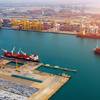Local Content
As Brazil continues to emerge as a global offshore and shipbuilding powerhouse, are its local content laws hindering progress?
Brazil’s Oil & Gas industry is in the midst of an unprecedented growth curve, with major new reservoirs being found in deepwater, the so-called pre-salt. This growth in the O&G industry has had a major influence in the growth of the nation’s shipbuilding industry, which until only a few short years ago was stagnant.
The main reason for this massive increase in shipbuilding and also in the construction of new shipyards is that the O&G industry demands various kinds of ships and support vessels in order to properly operate and maintain growth. Although it is always possible to buy ships of foreign make, the Brazilian government policy is determined to strengthen local industry in order to avoid what many call the oil curse, where countries rich in oil fail to develop their local manufacturing industries and end up completely dependent in foreign equipment and manufacturing capabilities, therefore strangling their own growth potential and usually sustaining high unemployment levels, along with increasing costs of related to Oil and Gas E&P. Unfortunately, good examples of countries that have this problem abound, in Latin America, including Mexico and Venezuela, as well as most West African oil producers.
Local Content in the Oil & Gas industry
The local content policy introduced by the Brazilian government is intended to strengthen local manufacturers that supply the O&G industry in such a way as to make them competitive with foreign suppliers.
The local content policy includes a wide range of materials, equipment, systems and services, which are necessary for the different industries, in this case specifically the O&G and shipbuilding industries in Brazil. The purpose of local content requirements is to allow local goods and service providers to participate in the O&G supply chain and increase their market share in a competitive basis. The system is intended to foster the development of Brazilian industry, high-end technological development, human resources development, employment and income.
In short, local content is the percentage of materials, equipment, systems and services produced locally in relation to the total amount of purchases made by a concessionaire currently operating in Brazil.
Brazilian concession contracts for exploration and production contain a clause requiring operators to purchase a certain percentage of goods and services from locally established providers.
Local providers are required to offer conditions of price, term and quality equivalent to those offered by foreign competitors. The percentage required may vary depending on the product and the amount of goods and services available in relation to the demand, in some cases local content requirement have been lowered in order not to negatively influence an industry’s growth. This usually only occurs when there are not enough qualified local workers for a given job or when specialized goods required are not locally available or do not have the necessary quality standards that the industry demands.
Brazil’s National Petroleum Agency (ANP) is responsible, among other things, for formulating and overseeing the country’s local content policy in relation to the O&G industry. The ANP has been using local content criterion when assessing business proposals ever since the first bidding round of blocks for exploration and production, which took place in 1999.
According to the ANP, up until the fourth bidding round in 2002, local content percentages were free. As of the fifth and sixth rounds in 2003 and 2004 respectively, however, ANP has established minimum percentages based on whether blocks were located onshore, offshore shallow water or offshore deepwater.
From the seventh round in 2005 onwards, contracts have included minimum and maximum percentages of local content for a set of specialized items used in the exploration and production development phases.
To ensure compliance with the local content policy, ANP monitors local content requirements by quarterly auditing investments and operations of each concessionaire. The ANP will inspect local content compliance during three phases of the Exploration and Production cycle:
1) Upon completion of the exploration phase;
2) At the end of the production development phase.
3) When the exploration block is returned and the concession contract is ended.
Block operators provide ANP with contracts and invoices showing their investments on all three phases. The documentation is then audited by the ANP and if local content percentages reach or exceed the set value, the ANP will give its approval and if not the block operator may be penalized by a hefty fine. In 2007, after a protracted and heated process of public consultations and hearings, ANP finally released the Local Content Certification System (ANP Resolutions 36 through 39/2007), which establishes local content rules for all contracts signed since Round 7.
Certification activities involve collecting data on the origin of components supplied, measuring local content and issuing certificates. By attaching these certificates to all invoices, concessionaires will testify to ANP that goods and services have been produced or provided locally. According to this system, ANP accredited independent firms are responsible for checking and subsequently certifying the local content of goods and services in the oil industry based on the Local Content Primer, which was developed by the Brazil’s Program for Mobilization of the Oil and Gas Industry (Prominp).
There are currently 21 ANP accredited certification firms, and by 2011 over 7,500 certificates had been issued to more than 400 local providers, evidencing more than $2 billion worth of investments in Brazil.
This investment is a direct spin-off from the government’s local content policy and it helps local industry to become more competitive and fosters all levels of workforce training including specialized geologists and engineers, a variety of technicians, and all sectors basic workforce, which is a significant gain for a country such as Brazil which deals with high levels of poverty.
The building of shipyards in very poor areas such as the EAS shipyard in Ipoyuca, Ceara, has also brought tangible social and economic gains to these locations, therefore the importance of the local content policy must be emphasized even considering the drawbacks and bottleneck the policy may cause in the industry. The main problem is the lack of a workforce pool from which to draw.
Local Content in the Shipbuilding Industry
In the late 1970’s the Brazilian shipbuilding industry was the second largest in the world. It directly employed 40,000 workers with an additional 100,000 indirect jobs supporting the industry. The debt crisis in the 1980s led to limitations on capital availability leading buyers to redirect orders to upstart firms in Japan, Singapore, South Korea and later China, who were able to offer lower costs and better schedule reliability. By the late 1990s the industry had all but disappeared; shipyards closed, unfinished projects were abandoned on the ways; and only about 2,000 jobs remained.
Circumstances changed in the late 1990s with the discovery of significant oil reserves in the Campos basin off the coast of the state of Rio de Janeiro. The Brazilian government auctioned off exploration blocks and through the initiatives of the national operator, Petrobras, along with other firms in the global oil industry, there were multiple discoveries of deepwater oil reserves.
In the early 2000s discoveries in the “pre-salt” area off the Northeast coast led to anticipation that Brazil would become a major exporter of oil as these reserves were developed to their full commercial potential. Around 2007, major pre-salt plays were discovered in the Santos Basin, mostly located in deep waters, far from shore.
This confirmed that the country had a true potential to become a major oil exporter. It brought to earth the need for a variety of rigs, drillships, crude and LNG tankers and support vessels to serve the O&G industry and as a direct consequence a rebirth of the local shipbuilding industry was required.
The Brazilian shipbuilding industry has been embarked on an impressive growth curve, growing from a low of less than 2,000 jobs in the year 2000 to the current level of around 60,000 jobs. Shipyards that had been mothballed are now revived, and new purpose built facilities -- everything from small yards that build only modules for rigs to major shipyards which intend to compete with the big shipyards in China and Korea which currently dominate the world market. All firms involved in shipyard construction, shipbuilding, including equipment manufacturers and service providers are required to fulfill local content demands.
Shipbuilding policy in Brazil is overseen by SINAVAL, which is the Brazilian shipbuilders union.
SINAVAL and ONIP (National Organization of the Petroleum Industry) developed a local content database for the shipbuilding industry which includes equipment, products and materials needed by shipyards, these are based on real case purchases for a PSV, a Tanker and an FPSO.
The database is shared with the supply chain in order to increase local production (see Table below).Franco Papini, SINAVAL’s executive vice-president, coordinates the local content initiative. Policy on local content in the workforce is decided by the Brazilian government and implemented by Sinaval. Local content production for tankers, drillships, rigs and support vessels involves training of human resources for workforce and supply of equipment. The compliance with local content commitments are monitored by Sinaval, along with the ANP and the Ministry of Mines and Energy (MME). The supply of equipment includes 11 groups of equipment, 111 subgroups and a total of 534 items.
SINAVAL has signed agreements for the development of partnerships with institutions that represent industries in Argentina, Spain, Korea and Japan, in order to expand the options of Brazilian shipyards in the development of their activities.The new phase of expansion of the Brazilian shipbuilding industry aims to comply with Petrobras’ investment plan, as well as preparing the industry for the expansion of oceangoing shipping, coastal shipping and inland waterway transport. The increase of local content in shipbuilding is still a priority and the expected increase in workforce demand by the new shipyards and new orders from operational shipyards, places technical training and qualification of human resources as one of the main challenges of the industry along with increasing the amount and quality of local content in maritime equipment manufacture. There is still a long hurdle ahead of the industry in order to adequately maintain local content levels that comply to the demands of the industry, major training programs are underway, from federal technical training to private technical training such as the OSX sponsored ITN (Institute of Naval Technology). In both the O&G industry and the Shipbuilding industry, the main risk is that a bottleneck may be created in the industries if local content availiability does not reach the parameters demanded by each segment of the industries. This may cause serious delays in E&P efforts which force both the Brazilian government and regulatory agencies to be more flexible with local content demands; which is something that has already happened in some instances.
In the next five years we should have a good idea on how well the local content policy is working in Brazil, for now all that can be done is to increase the effort of training the workforce and preparing the equipment industry to compete with foreign brands well established in the market. The fact that many of these foreign firms are making joint ventures with local manufacturers and offering technology transfer is definitely positive, however we are still to see if all these efforts will be enough to keep up with the demand.
Workforce by segment
Engineers 10% 1,500
Technicians 10% 1,500
Specialized Workers 70% 10,500
Administrative 5% 750
Others 5% 750
*Source: Sinaval - January 2012
Shipyard Distribution and Workforce by State
State Jobs %
Rio de Janeiro 25,020 42.29
Amazonas 11,987 20.26
Pernambuco 9,798 16.56
Rio Grande do Sul 5,500 9.30
Santa Catarina 2,125 3.59
Bahia 2,125 3.59
Others 2,612 4.41
Total 59,167 100.00
*Source: Sinaval - January 2012
Shipyard Workforce: Last 50 Years
Years Workers
1960 1,400
1970 18,000
1979 39,000
2000 1,900
2006 19,000
2011 59,000
*Source: Sinaval - January 2012
Content by Vessel Type
Type Local Imported
Tanker 70.8% 29.2%
PSV 61% 39%
FPSO 64.2% 35.8%
*Source: Sinaval - January 2012
Brazilian Shipbuilding Figures
• 6.2 million DWT order book
• 11 New yards under construction
• 18 Offshore Oil Platforms
under construction
• 21 Offshore Deepwater
Drilling Rigs Bid
• 47 Shipyards operational
• 59k Workers directly employed
Petrobras Investment Program:
From 2011–2020 undertaking the world’s largest E&P
• 50 Production platforms
• 50 Drill rigs
• 500 Offshore supply vessels
• 130 Oil tankers
About ITN – the Institute of Naval Technology
Aimed at promoting research and development, projects, and sponsoring initiatives focused on technological development and innovation, OSX created the ITN – Institute of Naval Technology, which will is being developed in four phases. In the first phase of its development, ITN is training professionals in careers required to make up the teams that will work in the UCN Açu Shipyard and OSX Serviços. Under a contract with the Rio de Janeiro Industrial Federation, Firjan, facilitated by Senai-RJ, the Program for Professional Qualification in Shipbuilding was created to train 3,1 thousand professionals by 2013. The initiative is ITN´s first partnership and will invest approximately R$ 13 million to qualify professionals for the project.
* Source: OSX website
(As publsihed in the November 2012 edition of Maritime Reporter - www.marinelink.com)












